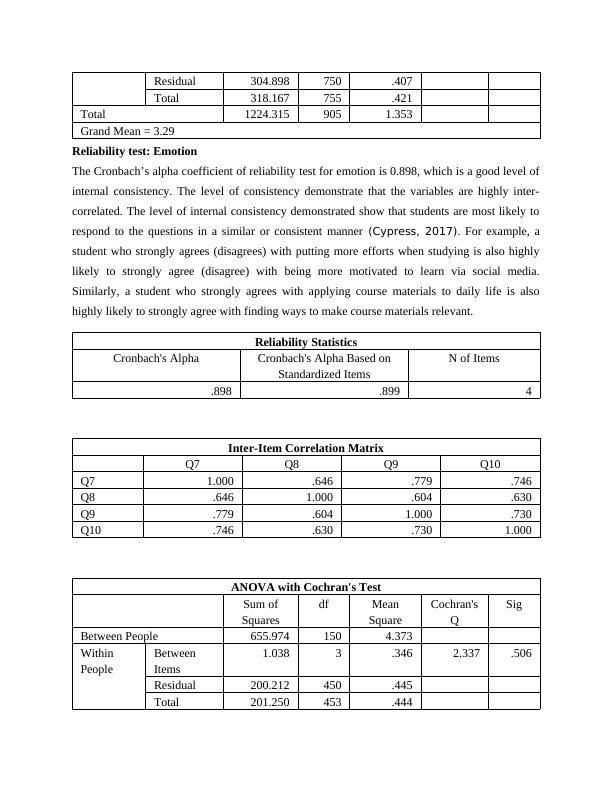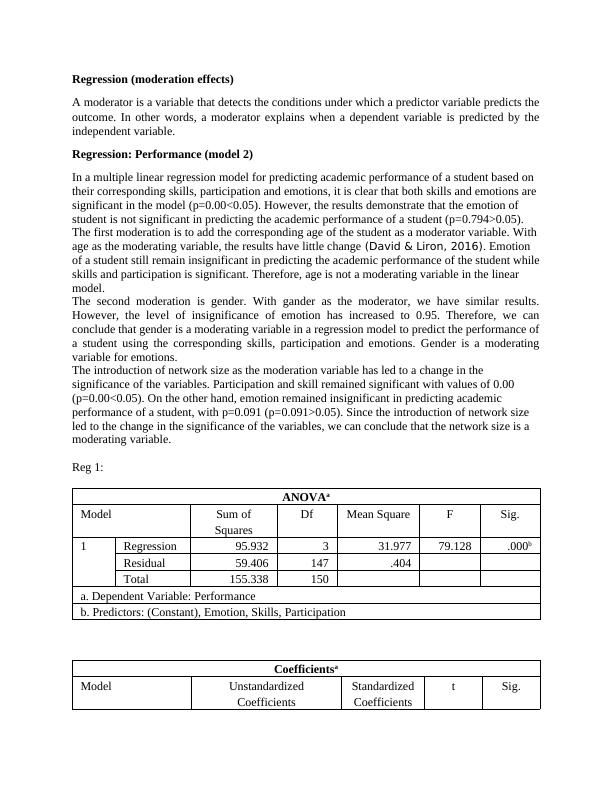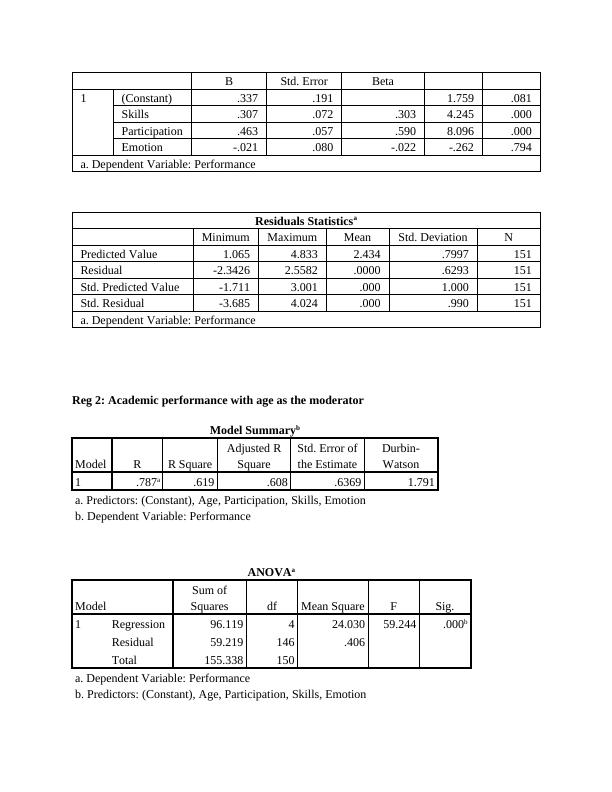Results and Interpretations PDF
Added on 2022-08-24
22 Pages5215 Words17 Views
Results and Interpretations
Reliability is a statistical test that is used to investigate the level of internal consistency among
variables of a categorical scale. The value of reliability ranges between 0 and 1. The value of the
coefficient of reliability increases either with the increase in the number of variables or with the
increase in inter-correlations (Fokkema, et al., 2017).
Reliability: Skills
The results of reliability test of the skill variables are shown below. The Cronbach’s alpha
coefficient is 0.933. The coefficient is greater than 0.9, implying that the variables have excellent
level of internal consistency or reliability. For example, student who strongly agrees with
studying on a regular basis is also highly likely to strongly agree with keeping up with learning
materials (Radakovic, et al., 2019). Similarly, a student who strongly agrees with listening
and reading carefully online information is also highly likely to strongly agree with taking good
notes over reading power point presentations.
Reliability Statistics
Cronbach's Alpha Cronbach's Alpha Based on
Standardized Items
N of Items
.933 .933 6
Inter-Item Correlation Matrix
Q1 Q2 Q3 Q4 Q5 Q6
Q1 1.000 .860 .675 .724 .630 .584
Q2 .860 1.000 .698 .762 .725 .620
Q3 .675 .698 1.000 .770 .622 .691
Q4 .724 .762 .770 1.000 .713 .749
Q5 .630 .725 .622 .713 1.000 .645
Q6 .584 .620 .691 .749 .645 1.000
ANOVA with Cochran's Test
Sum of
Squares
df Mean
Square
Cochran's
Q
Sig
Between People 906.148 150 6.041
Within
People
Between
Items
13.268 5 2.654 31.485 .000
Reliability is a statistical test that is used to investigate the level of internal consistency among
variables of a categorical scale. The value of reliability ranges between 0 and 1. The value of the
coefficient of reliability increases either with the increase in the number of variables or with the
increase in inter-correlations (Fokkema, et al., 2017).
Reliability: Skills
The results of reliability test of the skill variables are shown below. The Cronbach’s alpha
coefficient is 0.933. The coefficient is greater than 0.9, implying that the variables have excellent
level of internal consistency or reliability. For example, student who strongly agrees with
studying on a regular basis is also highly likely to strongly agree with keeping up with learning
materials (Radakovic, et al., 2019). Similarly, a student who strongly agrees with listening
and reading carefully online information is also highly likely to strongly agree with taking good
notes over reading power point presentations.
Reliability Statistics
Cronbach's Alpha Cronbach's Alpha Based on
Standardized Items
N of Items
.933 .933 6
Inter-Item Correlation Matrix
Q1 Q2 Q3 Q4 Q5 Q6
Q1 1.000 .860 .675 .724 .630 .584
Q2 .860 1.000 .698 .762 .725 .620
Q3 .675 .698 1.000 .770 .622 .691
Q4 .724 .762 .770 1.000 .713 .749
Q5 .630 .725 .622 .713 1.000 .645
Q6 .584 .620 .691 .749 .645 1.000
ANOVA with Cochran's Test
Sum of
Squares
df Mean
Square
Cochran's
Q
Sig
Between People 906.148 150 6.041
Within
People
Between
Items
13.268 5 2.654 31.485 .000

Residual 304.898 750 .407
Total 318.167 755 .421
Total 1224.315 905 1.353
Grand Mean = 3.29
Reliability test: Emotion
The Cronbach’s alpha coefficient of reliability test for emotion is 0.898, which is a good level of
internal consistency. The level of consistency demonstrate that the variables are highly inter-
correlated. The level of internal consistency demonstrated show that students are most likely to
respond to the questions in a similar or consistent manner (Cypress, 2017). For example, a
student who strongly agrees (disagrees) with putting more efforts when studying is also highly
likely to strongly agree (disagree) with being more motivated to learn via social media.
Similarly, a student who strongly agrees with applying course materials to daily life is also
highly likely to strongly agree with finding ways to make course materials relevant.
Reliability Statistics
Cronbach's Alpha Cronbach's Alpha Based on
Standardized Items
N of Items
.898 .899 4
Inter-Item Correlation Matrix
Q7 Q8 Q9 Q10
Q7 1.000 .646 .779 .746
Q8 .646 1.000 .604 .630
Q9 .779 .604 1.000 .730
Q10 .746 .630 .730 1.000
ANOVA with Cochran's Test
Sum of
Squares
df Mean
Square
Cochran's
Q
Sig
Between People 655.974 150 4.373
Within
People
Between
Items
1.038 3 .346 2.337 .506
Residual 200.212 450 .445
Total 201.250 453 .444
Total 318.167 755 .421
Total 1224.315 905 1.353
Grand Mean = 3.29
Reliability test: Emotion
The Cronbach’s alpha coefficient of reliability test for emotion is 0.898, which is a good level of
internal consistency. The level of consistency demonstrate that the variables are highly inter-
correlated. The level of internal consistency demonstrated show that students are most likely to
respond to the questions in a similar or consistent manner (Cypress, 2017). For example, a
student who strongly agrees (disagrees) with putting more efforts when studying is also highly
likely to strongly agree (disagree) with being more motivated to learn via social media.
Similarly, a student who strongly agrees with applying course materials to daily life is also
highly likely to strongly agree with finding ways to make course materials relevant.
Reliability Statistics
Cronbach's Alpha Cronbach's Alpha Based on
Standardized Items
N of Items
.898 .899 4
Inter-Item Correlation Matrix
Q7 Q8 Q9 Q10
Q7 1.000 .646 .779 .746
Q8 .646 1.000 .604 .630
Q9 .779 .604 1.000 .730
Q10 .746 .630 .730 1.000
ANOVA with Cochran's Test
Sum of
Squares
df Mean
Square
Cochran's
Q
Sig
Between People 655.974 150 4.373
Within
People
Between
Items
1.038 3 .346 2.337 .506
Residual 200.212 450 .445
Total 201.250 453 .444

Total 857.224 603 1.422
Grand Mean = 3.26
Reliability: Participation
The Cronbach’s alpha coefficient of reliability test is 0.923, indicating that the variables have an
excellent level of internal consistency. Therefore, the students were consistent in answering
questions related to participation (Pushkarev, et al., 2018). For instant, a student who
strongly agrees to having fun in online chats or discussions is also highly likely to strongly agree
to engaging in online conversations. Similarly, a student who strongly agrees with posting
regularly in forums is also highly likely to getting to know other students.
Reliability Statistics
Cronbach's Alpha Cronbach's Alpha Based on
Standardized Items
N of Items
.923 .922 6
Inter-Item Correlation Matrix
Q11 Q12 Q13 Q14 Q15 Q16
Q11 1.000 .522 .737 .702 .772 .730
Q12 .522 1.000 .632 .507 .519 .526
Q13 .737 .632 1.000 .733 .823 .676
Q14 .702 .507 .733 1.000 .781 .624
Q15 .772 .519 .823 .781 1.000 .687
Q16 .730 .526 .676 .624 .687 1.000
ANOVA with Cochran's Test
Sum of
Squares
df Mean
Square
Cochran's
Q
Sig
Between People 1021.311 150 6.809
Within
People
Between
Items
5.996 5 1.199 11.393 .044
Residual 391.338 750 .522
Total 397.333 755 .526
Total 1418.645 905 1.568
Grand Mean = 3.26
Reliability: Participation
The Cronbach’s alpha coefficient of reliability test is 0.923, indicating that the variables have an
excellent level of internal consistency. Therefore, the students were consistent in answering
questions related to participation (Pushkarev, et al., 2018). For instant, a student who
strongly agrees to having fun in online chats or discussions is also highly likely to strongly agree
to engaging in online conversations. Similarly, a student who strongly agrees with posting
regularly in forums is also highly likely to getting to know other students.
Reliability Statistics
Cronbach's Alpha Cronbach's Alpha Based on
Standardized Items
N of Items
.923 .922 6
Inter-Item Correlation Matrix
Q11 Q12 Q13 Q14 Q15 Q16
Q11 1.000 .522 .737 .702 .772 .730
Q12 .522 1.000 .632 .507 .519 .526
Q13 .737 .632 1.000 .733 .823 .676
Q14 .702 .507 .733 1.000 .781 .624
Q15 .772 .519 .823 .781 1.000 .687
Q16 .730 .526 .676 .624 .687 1.000
ANOVA with Cochran's Test
Sum of
Squares
df Mean
Square
Cochran's
Q
Sig
Between People 1021.311 150 6.809
Within
People
Between
Items
5.996 5 1.199 11.393 .044
Residual 391.338 750 .522
Total 397.333 755 .526
Total 1418.645 905 1.568

Grand Mean = 2.45
Reliability test: Academic Performance (model 1)
The students were highly consistent in answering the questions about academic performance as
demonstrated by the reliability test. The Cronbach’s alpha coefficient demonstrates that there
was a good level of internal constancy (alpha=0.883) between the questions about academic
performance (Cypress, 2017). The good level of internal consistency reveal that a student who
strongly agrees to be doing well in online tests is also highly likely to strongly agree to be getting
good grades.
Reliability Statistics
Cronbach's Alpha Cronbach's Alpha Based on
Standardized Items
N of Items
.883 .884 2
Inter-Item Correlation Matrix
Q17 Q18
Q17 1.000 .792
Q18 .792 1.000
ANOVA with Cochran's Test
Sum of
Squares
df Mean
Square
Cochran's
Q
Sig
Between People 483.093 150 3.221
Within
People
Between
Items
2.070 1 2.070 5.342 .021
Residual 56.430 150 .376
Total 58.500 151 .387
Total 541.593 301 1.799
Grand Mean = 2.42
Reliability test: Academic Performance (model 1)
The students were highly consistent in answering the questions about academic performance as
demonstrated by the reliability test. The Cronbach’s alpha coefficient demonstrates that there
was a good level of internal constancy (alpha=0.883) between the questions about academic
performance (Cypress, 2017). The good level of internal consistency reveal that a student who
strongly agrees to be doing well in online tests is also highly likely to strongly agree to be getting
good grades.
Reliability Statistics
Cronbach's Alpha Cronbach's Alpha Based on
Standardized Items
N of Items
.883 .884 2
Inter-Item Correlation Matrix
Q17 Q18
Q17 1.000 .792
Q18 .792 1.000
ANOVA with Cochran's Test
Sum of
Squares
df Mean
Square
Cochran's
Q
Sig
Between People 483.093 150 3.221
Within
People
Between
Items
2.070 1 2.070 5.342 .021
Residual 56.430 150 .376
Total 58.500 151 .387
Total 541.593 301 1.799
Grand Mean = 2.42

Regression (moderation effects)
A moderator is a variable that detects the conditions under which a predictor variable predicts the
outcome. In other words, a moderator explains when a dependent variable is predicted by the
independent variable.
Regression: Performance (model 2)
In a multiple linear regression model for predicting academic performance of a student based on
their corresponding skills, participation and emotions, it is clear that both skills and emotions are
significant in the model (p=0.00<0.05). However, the results demonstrate that the emotion of
student is not significant in predicting the academic performance of a student (p=0.794>0.05).
The first moderation is to add the corresponding age of the student as a moderator variable. With
age as the moderating variable, the results have little change (David & Liron, 2016). Emotion
of a student still remain insignificant in predicting the academic performance of the student while
skills and participation is significant. Therefore, age is not a moderating variable in the linear
model.
The second moderation is gender. With gander as the moderator, we have similar results.
However, the level of insignificance of emotion has increased to 0.95. Therefore, we can
conclude that gender is a moderating variable in a regression model to predict the performance of
a student using the corresponding skills, participation and emotions. Gender is a moderating
variable for emotions.
The introduction of network size as the moderation variable has led to a change in the
significance of the variables. Participation and skill remained significant with values of 0.00
(p=0.00<0.05). On the other hand, emotion remained insignificant in predicting academic
performance of a student, with p=0.091 (p=0.091>0.05). Since the introduction of network size
led to the change in the significance of the variables, we can conclude that the network size is a
moderating variable.
Reg 1:
ANOVAa
Model Sum of
Squares
Df Mean Square F Sig.
1 Regression 95.932 3 31.977 79.128 .000b
Residual 59.406 147 .404
Total 155.338 150
a. Dependent Variable: Performance
b. Predictors: (Constant), Emotion, Skills, Participation
Coefficientsa
Model Unstandardized
Coefficients
Standardized
Coefficients
t Sig.
A moderator is a variable that detects the conditions under which a predictor variable predicts the
outcome. In other words, a moderator explains when a dependent variable is predicted by the
independent variable.
Regression: Performance (model 2)
In a multiple linear regression model for predicting academic performance of a student based on
their corresponding skills, participation and emotions, it is clear that both skills and emotions are
significant in the model (p=0.00<0.05). However, the results demonstrate that the emotion of
student is not significant in predicting the academic performance of a student (p=0.794>0.05).
The first moderation is to add the corresponding age of the student as a moderator variable. With
age as the moderating variable, the results have little change (David & Liron, 2016). Emotion
of a student still remain insignificant in predicting the academic performance of the student while
skills and participation is significant. Therefore, age is not a moderating variable in the linear
model.
The second moderation is gender. With gander as the moderator, we have similar results.
However, the level of insignificance of emotion has increased to 0.95. Therefore, we can
conclude that gender is a moderating variable in a regression model to predict the performance of
a student using the corresponding skills, participation and emotions. Gender is a moderating
variable for emotions.
The introduction of network size as the moderation variable has led to a change in the
significance of the variables. Participation and skill remained significant with values of 0.00
(p=0.00<0.05). On the other hand, emotion remained insignificant in predicting academic
performance of a student, with p=0.091 (p=0.091>0.05). Since the introduction of network size
led to the change in the significance of the variables, we can conclude that the network size is a
moderating variable.
Reg 1:
ANOVAa
Model Sum of
Squares
Df Mean Square F Sig.
1 Regression 95.932 3 31.977 79.128 .000b
Residual 59.406 147 .404
Total 155.338 150
a. Dependent Variable: Performance
b. Predictors: (Constant), Emotion, Skills, Participation
Coefficientsa
Model Unstandardized
Coefficients
Standardized
Coefficients
t Sig.

B Std. Error Beta
1 (Constant) .337 .191 1.759 .081
Skills .307 .072 .303 4.245 .000
Participation .463 .057 .590 8.096 .000
Emotion -.021 .080 -.022 -.262 .794
a. Dependent Variable: Performance
Residuals Statisticsa
Minimum Maximum Mean Std. Deviation N
Predicted Value 1.065 4.833 2.434 .7997 151
Residual -2.3426 2.5582 .0000 .6293 151
Std. Predicted Value -1.711 3.001 .000 1.000 151
Std. Residual -3.685 4.024 .000 .990 151
a. Dependent Variable: Performance
Reg 2: Academic performance with age as the moderator
Model Summaryb
Model R R Square
Adjusted R
Square
Std. Error of
the Estimate
Durbin-
Watson
1 .787a .619 .608 .6369 1.791
a. Predictors: (Constant), Age, Participation, Skills, Emotion
b. Dependent Variable: Performance
ANOVAa
Model
Sum of
Squares df Mean Square F Sig.
1 Regression 96.119 4 24.030 59.244 .000b
Residual 59.219 146 .406
Total 155.338 150
a. Dependent Variable: Performance
b. Predictors: (Constant), Age, Participation, Skills, Emotion
1 (Constant) .337 .191 1.759 .081
Skills .307 .072 .303 4.245 .000
Participation .463 .057 .590 8.096 .000
Emotion -.021 .080 -.022 -.262 .794
a. Dependent Variable: Performance
Residuals Statisticsa
Minimum Maximum Mean Std. Deviation N
Predicted Value 1.065 4.833 2.434 .7997 151
Residual -2.3426 2.5582 .0000 .6293 151
Std. Predicted Value -1.711 3.001 .000 1.000 151
Std. Residual -3.685 4.024 .000 .990 151
a. Dependent Variable: Performance
Reg 2: Academic performance with age as the moderator
Model Summaryb
Model R R Square
Adjusted R
Square
Std. Error of
the Estimate
Durbin-
Watson
1 .787a .619 .608 .6369 1.791
a. Predictors: (Constant), Age, Participation, Skills, Emotion
b. Dependent Variable: Performance
ANOVAa
Model
Sum of
Squares df Mean Square F Sig.
1 Regression 96.119 4 24.030 59.244 .000b
Residual 59.219 146 .406
Total 155.338 150
a. Dependent Variable: Performance
b. Predictors: (Constant), Age, Participation, Skills, Emotion

End of preview
Want to access all the pages? Upload your documents or become a member.
